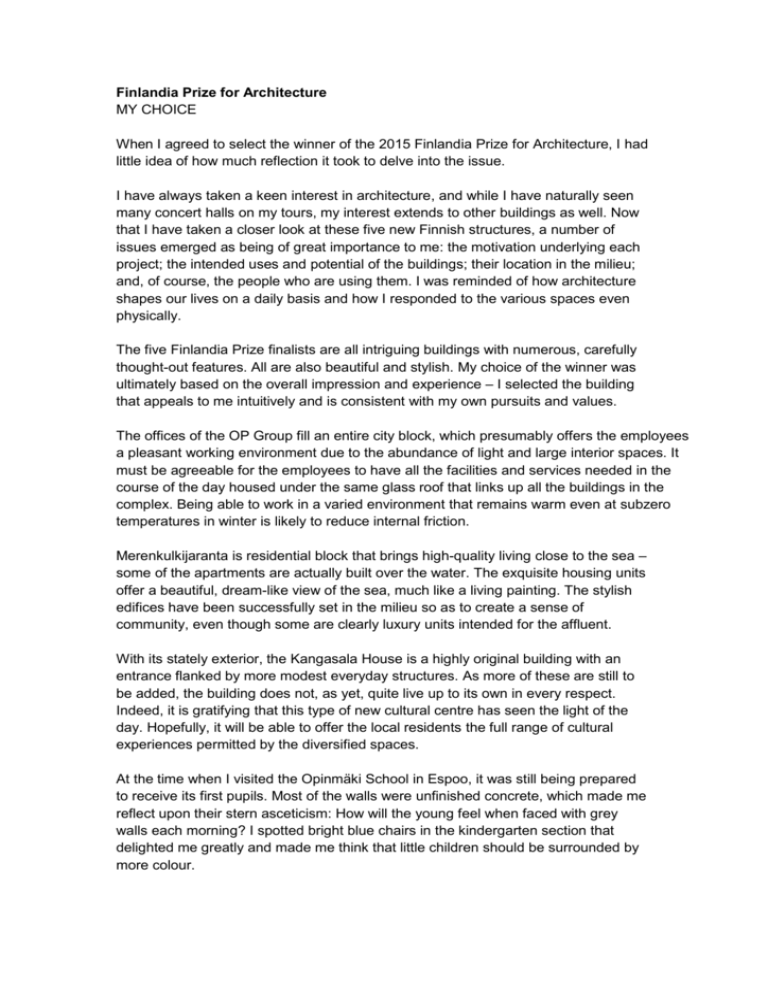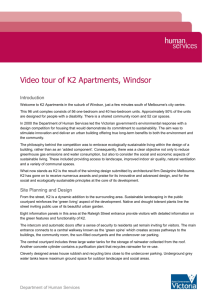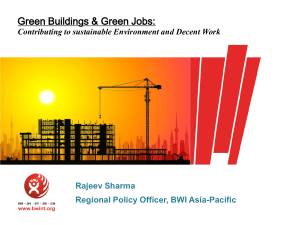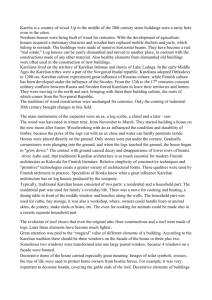Finlandia Prize for Architecture MY CHOICE When I agreed to select
advertisement

Finlandia Prize for Architecture MY CHOICE When I agreed to select the winner of the 2015 Finlandia Prize for Architecture, I had little idea of how much reflection it took to delve into the issue. I have always taken a keen interest in architecture, and while I have naturally seen many concert halls on my tours, my interest extends to other buildings as well. Now that I have taken a closer look at these five new Finnish structures, a number of issues emerged as being of great importance to me: the motivation underlying each project; the intended uses and potential of the buildings; their location in the milieu; and, of course, the people who are using them. I was reminded of how architecture shapes our lives on a daily basis and how I responded to the various spaces even physically. The five Finlandia Prize finalists are all intriguing buildings with numerous, carefully thought-out features. All are also beautiful and stylish. My choice of the winner was ultimately based on the overall impression and experience – I selected the building that appeals to me intuitively and is consistent with my own pursuits and values. The offices of the OP Group fill an entire city block, which presumably offers the employees a pleasant working environment due to the abundance of light and large interior spaces. It must be agreeable for the employees to have all the facilities and services needed in the course of the day housed under the same glass roof that links up all the buildings in the complex. Being able to work in a varied environment that remains warm even at subzero temperatures in winter is likely to reduce internal friction. Merenkulkijaranta is residential block that brings high-quality living close to the sea – some of the apartments are actually built over the water. The exquisite housing units offer a beautiful, dream-like view of the sea, much like a living painting. The stylish edifices have been successfully set in the milieu so as to create a sense of community, even though some are clearly luxury units intended for the affluent. With its stately exterior, the Kangasala House is a highly original building with an entrance flanked by more modest everyday structures. As more of these are still to be added, the building does not, as yet, quite live up to its own in every respect. Indeed, it is gratifying that this type of new cultural centre has seen the light of the day. Hopefully, it will be able to offer the local residents the full range of cultural experiences permitted by the diversified spaces. At the time when I visited the Opinmäki School in Espoo, it was still being prepared to receive its first pupils. Most of the walls were unfinished concrete, which made me reflect upon their stern asceticism: How will the young feel when faced with grey walls each morning? I spotted bright blue chairs in the kindergarten section that delighted me greatly and made me think that little children should be surrounded by more colour. Of all the finalists, the greatest impression was made by Puukuokka, a timber-framed high-rise building complex on the human scale aiming for a new type of ecological construction. Thanks to the extensive use of wood, the acoustics were pleasant and cosy even in the staircase. It was also airy and spacious because of its large size. The views of one of the residents I visited on the superiority of a wood-clad dwelling – especially in terms of acoustics and comfort – convinced me. I could sense the welcoming atmosphere when entering the home. The apartments are average in size with floor areas ranging from 53 to 76 square metres. All are equipped with either a recessed or extended balcony, an ideal solution considering the Finnish climate. The side facing the yard looks over a copse of trees while the large staircase windows offer a view of a forest landscape in several directions. The cosy staircase and inviting apartments seemed to give a promise of a new human-scale approach to construction, a concept consistent with the Finnish and even Nordic way of living. So why not adopt it elsewhere? During my visit, I began to gain an insight into the fire safety regulations advocated by the concrete industry that have traditionally imposed stringent restrictions on the use of wood in construction in Finland. As a result, it used to be impossible to build this type of multistory buildings in the country. It is just another example of how financial interests may impede progress in finding ecological solutions – increased living comfort and the emergence of a new kind of construction as in this case! The Puukuokka project selected by me as the winner combines elements that I value both in architecture and life: it is a bold and ambitious piece of work that seeks to explore something new, aim for the human, develop ecological concepts and improve the quality of life. I feel that I can subscribe to the aesthetic and ethical choices made by the architects. Moreover, Puukuokka is the building that I enjoyed most with all my senses. Kaija Saariaho 20 August 2015











